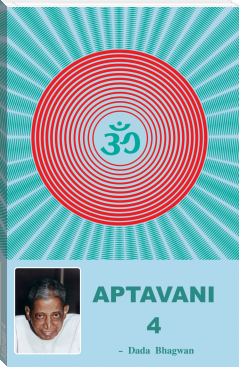Among the Forces by Henry White Warren (no david read aloud .TXT) 📖

Download in Format:
- Author: Henry White Warren
Book online «Among the Forces by Henry White Warren (no david read aloud .TXT) 📖». Author Henry White Warren
It is of no use to try to put it out by water, for it only makes more heat. He knew that dried alum and sugar suitably mixed would burst into flame if exposed to the air; that nitric acid and oil of turpentine would take fire if mixed; that flint struck by steel would start fire enough to explode a powder magazine; and that Elijah called down from heaven a kind of fire that burned twelve "barrels" of water as easily as ordinary water puts out ordinary fire. But he had none of these ways of lighting his candle at hand--not even the last.
So he took a bit of potassium metal, bright as silver, out of a bottle of naphtha, put it in the candle wick, touched it with a bit of dripping ice, and so lighted his candle.
The potassium was so avaricious of oxygen that it decomposed the water to get it. Indeed, it was a case of mutual affection. The oxygen preferred the company of potassium to that of the hydrogen in the water, and went to it even at the risk of being burned.
I was so interested in seeing a bit of silver-like metal and water take fire as they touched that I forgot all about the occasion of the noise.
HINT HELP
Benjamin C. B. Tilghman, of Philadelphia, once went into the lighthouse at Cape May, and, observing that the window glass was translucent rather than transparent, asked the keeper why he put ground glass in the windows. "We do not," said the keeper. "We put in the clear glass, and the wind blows the sand against it and roughens the outer surface like ground glass." The answer was to him like the falling apple to Newton. He put on his thinking cap and went out. It was better than the cap of Fortunatus to him. He thought, "If nature does this, why cannot I make a fiercer blast, let sand trickle into it, and so hurl a million little hammers at the glass, and grind it more swiftly than we do on stones with a stream of wet sand added?"
He tried jets of steam and of air with sand, and found that he could roughen a pane of glass almost instantly. By coating a part of the glass with hot beeswax, applied with a brush, through a stencil, or covering it with paper cut into any desired figures, he could engrave the most delicate and intricate patterns as readily as if plain. Glass is often made all white, except a very thin coating of brilliant colored glass on one side. This he could cut through, leaving letters of brilliant color and the general surface white, or _vice versa_.
Seal cutting is a very delicate and difficult art, old as the Pharaohs. Protect the surface that is to be left, and the sand blast will cut out the required design neatly and swiftly.
There is no known substance, not even corundum, hard enough to resist the swift impact of myriads of little stones.
It will cut more granite into shape in an hour than a man can in a day.
Surely no one will be sorry to learn that General Tilghman sold part of his patents, taken out in October, 1870, for $400,000, and receives the untold benefits of the rest to this day. So much for thinking.
Nature gives thousands of hints. Some can take them; some can only take the other thing. The hints are greatly preferred by nature and man.
CREATIONS NOW IN PROGRESS
The forces of creation are yet in full play. Who can direct them? Rewards greater than Tilghman's await the thinker. We are permitted not only to think God's thoughts after him, but to do his works. "Greater works than these that I do shall he do who believeth on me," says the Greatest Worker. Great profit incites to do the work noted below.
Carbon as charcoal is worth about six cents a bushel; as plumbago, for lead pencils or for the bicycle chain, it is worth more; as diamond it has been sold for $500,000 for less than an ounce, and that was regarded as less than half its value. Such a stone is so valuable that $15,000 has been spent in grinding and polishing its surface. The glazier pays $5.00 for a bit of carbon so small that it would take about ten thousand of them to make an ounce.
Why is there such a difference in value? Simply arrangement and compactness. Can we so enormously enhance the value of a bushel of charcoal by arrangement and compression? Not very satisfactorily as yet. We can apply almost limitless pressure, but that does not make diamonds. Every particle must go to its place by some law and force we have not yet attained the mastery of.
We do not know and control the law and force in nature that would enable us to say to a few million bricks, stones, bits of glass, etc., "Fly up through earth, water, and air, and combine into a perfect palace, with walls, buttresses, towers, and windows all in exact architectural harmony." But there is such a law and force for crystals, if not for palaces. There is wisdom to originate and power to manage such a force. It does not take masses of rock and stick them together, nor even particles from a fluid, but atoms from a gas. Atoms as fine as those of air must be taken and put in their place, one by one, under enormous pressure, to have the resulting crystal as compact as a diamond.
The force of crystallization is used by us in many inferior ways, as in making crystals of rock candy, sulphur, salt, etc., but for the making of diamonds it is too much for us, except in a small way.
While we cannot yet use the force that builds large white diamonds we can use the diamonds themselves. Set a number of them around a section of an iron tube, place it against a rock, at the surface or deep down in a mine, cause it to revolve rapidly by machinery, and it will bore into the rock, leaving a core. Force in water, to remove the dust and chips, and the diamond teeth will eat their way hundreds of feet in any direction; and by examining the extracted core miners can tell what sort of ore there is hundreds of feet in advance. Hence, they go only where they know that value lies.
SOME CURIOUS BEHAVIORS OF ATOMS
Ultimate atoms of matter are asserted to be impenetrable. That is, if a mass of them really touched each other, that mass would not be condensible by any force. But atoms of matter do not touch. It is thinkable, but not demonstrable, that condensation might go on till there were no discernible substance left, only force.
Matter exists in three states: solid, liquid, and gas. It is thought that all matter may be passed through the three stages--iron being capable of being volatilized, and gases condensed to liquids and solids--the chief difference of these states being greater or less distance between the constituent atoms and molecules. In gas the particles are distant from each other, like gnats flying in the air; in liquids, distant as men passing in a busy street; in solids, as men in a congregation, so sparse that each can easily move about. The congregation can easily disperse to the rarity of those walking in the street, and the men in the street condense to the density of the congregation. So, matter can change in going from solids to liquids and gases, or _vice versa_. The behavior of atoms in the process is surpassingly interesting.
Gold changes its density, and therefore its thickness, between the two dies of the mint that make it money. How do the particles behave as they snuggle up closer to each other?
Take a piece of iron wire and bend it. The atoms on the inner side become nearer together, those on the outside farther apart. Twist it. The outer particles revolve on each other; those of the middle do not move. They assume and maintain their new relations.
Hang a weight on a wire. It does not stretch like a rubber thread, but it stretches. Eight wires were tested as to their tensile strength. They gave an average of forty-five pounds, and an elongation averaging nineteen per cent of the total length. Then a wire of the same kind was given time to adjust itself to its new and trying circumstances. Forty pounds were hung on one day, three pounds more the next day, and so on, increasing the weights by diminishing quantities, till in sixty days it carried fifty-seven pounds. So it seems that exercise strengthened the wire nearly twenty-seven per cent.
While those atoms are hustling about, lengthening the wire and getting a better grip on one another, they grow warm with the exercise. Hold a thick rubber band against your lip--suddenly stretch it. The lip easily perceives the greater heat. After a few moments let it contract. The greater coldness is equally perceptible.
A wire suspending thirty-nine pounds being twisted ninety-five full turns lengthened itself one sixteen-hundredth of its length. Being further twisted by twenty-five turns it shortened itself one fourth of its previous elongation. During the twisting some sections took far more torsion than others. A steel wire supporting thirty-nine pounds was twisted one hundred and twenty times and then allowed to untwist at will. It let out only thirty-eight turns and retained eighty-two in the new permanent relation of particles. A wire has been known to accommodate itself to nearly fourteen hundred twists, and still the atoms did not let go of each other. They slid about on each other as freely as the atoms of water, but they still held on. It is easier to conceive of these atoms sliding about, making the wire thinner and longer, when we consider that it is the opinion of our best physicists that molecules made of atoms are never still. Masses of matter may be still, but not the constituent elements. They are always in intensest activity, like a mass of bees--those inside coming out, outside ones going in--but the mass remains the same.
The atoms of water behave extraordinarily. I know of a boiler and pipes for heating a house. When the fire was applied and the temperature was changed from that of the street to two hundred degrees, it was easy to see that there was a whole barrel more of it than when it was let into the boiler. It had been swollen by the heat, but it was nothing but water.
Mobile, flexible, and yielding as water seems to be, it has an obstinacy quite remarkable. It was for a long time supposed to be absolutely incompressible. It is nearly so. A pressure that would reduce air to one hundredth of its bulk would not discernibly affect water. Put a ton weight on a cubic inch of water; it does not flinch nor perceptibly shrink, yet the atoms of water do not fill the space they occupy. They object to being crowded. They make no objection to having other matter come in and possess the space unoccupied
So he took a bit of potassium metal, bright as silver, out of a bottle of naphtha, put it in the candle wick, touched it with a bit of dripping ice, and so lighted his candle.
The potassium was so avaricious of oxygen that it decomposed the water to get it. Indeed, it was a case of mutual affection. The oxygen preferred the company of potassium to that of the hydrogen in the water, and went to it even at the risk of being burned.
I was so interested in seeing a bit of silver-like metal and water take fire as they touched that I forgot all about the occasion of the noise.
HINT HELP
Benjamin C. B. Tilghman, of Philadelphia, once went into the lighthouse at Cape May, and, observing that the window glass was translucent rather than transparent, asked the keeper why he put ground glass in the windows. "We do not," said the keeper. "We put in the clear glass, and the wind blows the sand against it and roughens the outer surface like ground glass." The answer was to him like the falling apple to Newton. He put on his thinking cap and went out. It was better than the cap of Fortunatus to him. He thought, "If nature does this, why cannot I make a fiercer blast, let sand trickle into it, and so hurl a million little hammers at the glass, and grind it more swiftly than we do on stones with a stream of wet sand added?"
He tried jets of steam and of air with sand, and found that he could roughen a pane of glass almost instantly. By coating a part of the glass with hot beeswax, applied with a brush, through a stencil, or covering it with paper cut into any desired figures, he could engrave the most delicate and intricate patterns as readily as if plain. Glass is often made all white, except a very thin coating of brilliant colored glass on one side. This he could cut through, leaving letters of brilliant color and the general surface white, or _vice versa_.
Seal cutting is a very delicate and difficult art, old as the Pharaohs. Protect the surface that is to be left, and the sand blast will cut out the required design neatly and swiftly.
There is no known substance, not even corundum, hard enough to resist the swift impact of myriads of little stones.
It will cut more granite into shape in an hour than a man can in a day.
Surely no one will be sorry to learn that General Tilghman sold part of his patents, taken out in October, 1870, for $400,000, and receives the untold benefits of the rest to this day. So much for thinking.
Nature gives thousands of hints. Some can take them; some can only take the other thing. The hints are greatly preferred by nature and man.
CREATIONS NOW IN PROGRESS
The forces of creation are yet in full play. Who can direct them? Rewards greater than Tilghman's await the thinker. We are permitted not only to think God's thoughts after him, but to do his works. "Greater works than these that I do shall he do who believeth on me," says the Greatest Worker. Great profit incites to do the work noted below.
Carbon as charcoal is worth about six cents a bushel; as plumbago, for lead pencils or for the bicycle chain, it is worth more; as diamond it has been sold for $500,000 for less than an ounce, and that was regarded as less than half its value. Such a stone is so valuable that $15,000 has been spent in grinding and polishing its surface. The glazier pays $5.00 for a bit of carbon so small that it would take about ten thousand of them to make an ounce.
Why is there such a difference in value? Simply arrangement and compactness. Can we so enormously enhance the value of a bushel of charcoal by arrangement and compression? Not very satisfactorily as yet. We can apply almost limitless pressure, but that does not make diamonds. Every particle must go to its place by some law and force we have not yet attained the mastery of.
We do not know and control the law and force in nature that would enable us to say to a few million bricks, stones, bits of glass, etc., "Fly up through earth, water, and air, and combine into a perfect palace, with walls, buttresses, towers, and windows all in exact architectural harmony." But there is such a law and force for crystals, if not for palaces. There is wisdom to originate and power to manage such a force. It does not take masses of rock and stick them together, nor even particles from a fluid, but atoms from a gas. Atoms as fine as those of air must be taken and put in their place, one by one, under enormous pressure, to have the resulting crystal as compact as a diamond.
The force of crystallization is used by us in many inferior ways, as in making crystals of rock candy, sulphur, salt, etc., but for the making of diamonds it is too much for us, except in a small way.
While we cannot yet use the force that builds large white diamonds we can use the diamonds themselves. Set a number of them around a section of an iron tube, place it against a rock, at the surface or deep down in a mine, cause it to revolve rapidly by machinery, and it will bore into the rock, leaving a core. Force in water, to remove the dust and chips, and the diamond teeth will eat their way hundreds of feet in any direction; and by examining the extracted core miners can tell what sort of ore there is hundreds of feet in advance. Hence, they go only where they know that value lies.
SOME CURIOUS BEHAVIORS OF ATOMS
Ultimate atoms of matter are asserted to be impenetrable. That is, if a mass of them really touched each other, that mass would not be condensible by any force. But atoms of matter do not touch. It is thinkable, but not demonstrable, that condensation might go on till there were no discernible substance left, only force.
Matter exists in three states: solid, liquid, and gas. It is thought that all matter may be passed through the three stages--iron being capable of being volatilized, and gases condensed to liquids and solids--the chief difference of these states being greater or less distance between the constituent atoms and molecules. In gas the particles are distant from each other, like gnats flying in the air; in liquids, distant as men passing in a busy street; in solids, as men in a congregation, so sparse that each can easily move about. The congregation can easily disperse to the rarity of those walking in the street, and the men in the street condense to the density of the congregation. So, matter can change in going from solids to liquids and gases, or _vice versa_. The behavior of atoms in the process is surpassingly interesting.
Gold changes its density, and therefore its thickness, between the two dies of the mint that make it money. How do the particles behave as they snuggle up closer to each other?
Take a piece of iron wire and bend it. The atoms on the inner side become nearer together, those on the outside farther apart. Twist it. The outer particles revolve on each other; those of the middle do not move. They assume and maintain their new relations.
Hang a weight on a wire. It does not stretch like a rubber thread, but it stretches. Eight wires were tested as to their tensile strength. They gave an average of forty-five pounds, and an elongation averaging nineteen per cent of the total length. Then a wire of the same kind was given time to adjust itself to its new and trying circumstances. Forty pounds were hung on one day, three pounds more the next day, and so on, increasing the weights by diminishing quantities, till in sixty days it carried fifty-seven pounds. So it seems that exercise strengthened the wire nearly twenty-seven per cent.
While those atoms are hustling about, lengthening the wire and getting a better grip on one another, they grow warm with the exercise. Hold a thick rubber band against your lip--suddenly stretch it. The lip easily perceives the greater heat. After a few moments let it contract. The greater coldness is equally perceptible.
A wire suspending thirty-nine pounds being twisted ninety-five full turns lengthened itself one sixteen-hundredth of its length. Being further twisted by twenty-five turns it shortened itself one fourth of its previous elongation. During the twisting some sections took far more torsion than others. A steel wire supporting thirty-nine pounds was twisted one hundred and twenty times and then allowed to untwist at will. It let out only thirty-eight turns and retained eighty-two in the new permanent relation of particles. A wire has been known to accommodate itself to nearly fourteen hundred twists, and still the atoms did not let go of each other. They slid about on each other as freely as the atoms of water, but they still held on. It is easier to conceive of these atoms sliding about, making the wire thinner and longer, when we consider that it is the opinion of our best physicists that molecules made of atoms are never still. Masses of matter may be still, but not the constituent elements. They are always in intensest activity, like a mass of bees--those inside coming out, outside ones going in--but the mass remains the same.
The atoms of water behave extraordinarily. I know of a boiler and pipes for heating a house. When the fire was applied and the temperature was changed from that of the street to two hundred degrees, it was easy to see that there was a whole barrel more of it than when it was let into the boiler. It had been swollen by the heat, but it was nothing but water.
Mobile, flexible, and yielding as water seems to be, it has an obstinacy quite remarkable. It was for a long time supposed to be absolutely incompressible. It is nearly so. A pressure that would reduce air to one hundredth of its bulk would not discernibly affect water. Put a ton weight on a cubic inch of water; it does not flinch nor perceptibly shrink, yet the atoms of water do not fill the space they occupy. They object to being crowded. They make no objection to having other matter come in and possess the space unoccupied
Free ebook «Among the Forces by Henry White Warren (no david read aloud .TXT) 📖» - read online now
Similar e-books:





Comments (0)